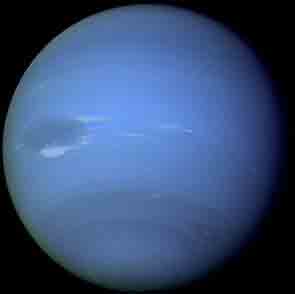|
         
> The Sun
> Mercury
> Venus
> Earth
> Mars
> Jupiter
> Saturn
> Uranus
> Neptune
> Pluto
> The 10th Planet?
> Asteroids
> Comets
> The 'Edge'
  
|
Neptune, like its twin,
Uranus, has an atmosphere composed of hydrogen, helium, methane, and
ammonia. The methane creates the blue color. Neptune's internal structure
is also the same as that of Uranus.

The core of Neptune is probably composed of liquid rock. Then, farther up,
the liquid rock slowly gives way to an ocean, primarily containing
hydrogen, helium, and water, but also ammonia and methane. This "ocean"
accounts for most of Neptune's bulk. The ocean slowly thins out into the
atmosphere.
This atmosphere contains much more detail than Uranus'. It has swirls of
clouds and high-altitude cirrus clouds, as well as gigantic storms.
Neptune also has a faint system of rings. The rings are made of pieces of
material the size of a car or truck. There is about one thousandth of the
matter in Neptune's rings as in Uranus'. If the rings were all rolled into
a ball, the ball would be only a couple of miles across. That matter is
spread across 125,000 km (77,500 miles).
In the outermost ring of Neptune, there are three anomalies called the
"Three Arcs of Neptune." They are areas where the rings are relatively
dense. Over the millions of years that these have existed, the particles
in the arcs should have spread out until the ring was a uniform density.
However, this has not happened. Scientists now believe that these arcs are
shepherded by small moons.
Unique
Characteristics
Neptune has a few features that no other planet has. Once
Uranus had been discovered, perturbations in its orbit were seen.
Calculations were made, and it was predicted that there should be a planet
within a certain patch of sky. Within hours, Neptune was discovered in
1846.

The first feature that is unique to Neptune is the Great Dark Spot (left).
It is a depression in the atmosphere surrounded by high cirrus clouds.
Neptune's Great Dark Spot does not appear to be stable, though. A few
years after the Voyagers found it, it had disappeared (Hubble Space
Telescope pictures at the right). Then, in 1995, it reappeared in
Neptune's northern hemisphere.

When the Great Dark Spot was first discovered, it was thought to be moving
very slowly. However, when Neptune's rotation rate was finally determined,
it showed that the Great Dark Spot wasn't moving slowly with the planet,
but was actually moving in a direction opposite the planet's spin at
almost supersonic speeds. These are ten times hurricane speeds on Earth.
[Top] Neptune's
Satellite
Neptune has 13 known moons. They are composed of rock and
ice. Triton has a retrograde orbit. Nereid has a highly elliptical orbit.
Voyager 2 discovered 6 of the moons not observable from Earth. Very
recently, three more moons, S/2002 N1-3, were discovered from a
ground-based telescope in 2002.The first four moons of Neptune, Naiad, Thalassa, Despina, and Galatea, are so close to Neptune that they orbit
within its ring system. Little is known about them.
The next one out, Larissa, was actually discovered in 1981, when it
blocked a star. This was attributed to the ring arcs, but later was found
to be the moon, being re-discovered by Voyager 2 in 1989.
Proteus is the second-largest moon in orbit around Neptune. It is so close
to the planet that Earth-bound telescopes cannot see it.
Triton is next, and is one of the strangest moons in the solar system.
First, it is one of only three moons in the solar system that has an
atmosphere (Jupiter's Io and Saturn's Titan are the other two). It is
thicker than Io's, yet much thinner than Titan's. Its pressure is
1/100,000 of Earth's.
The eighth moon, Nereid, has a highly elliptical orbit that causes it to
swing around Neptune at various distances. When closest, it is 1,342,530
km (834,210 miles) from the planet. At the farthest distance, it is
9,667,120 km (6,006,870 miles) from Neptune.
The last five moons were discovered in the first few weeks of and
throughout 2003. They have not yet been given official names by the
International Astronomical Union. Very little is yet known about them.
[Top] External Links
[Back] [Top] [Next] |


